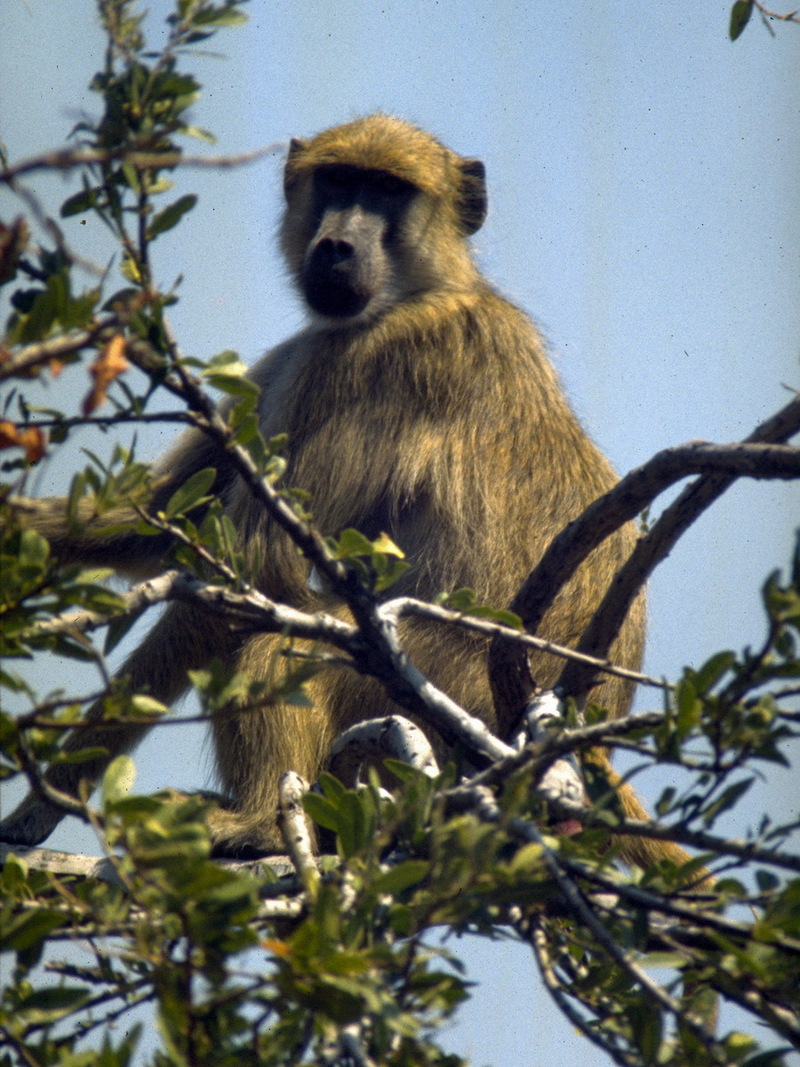Chacma Baboon
From Wikipedia, the free encyclopedia
[Photo] Papio ursinus - Chacma baboon. Photo by Hans Hillewaert. Cape Maclear - Malawi, 1990.
The Chacma Baboon (Papio ursinus), also known as the Cape Baboon, is, like all other baboons, from the Old World monkey family. With a body length of up to 115 cm and a weight from 15 to 31 kg, it is among the largest and heaviest baboon species. The Chacma is generally dark brown to gray in color, with a patch of rough hair on the nape of its neck. Unlike the northern baboon species (the Guinea, Hamadryas, and Olive Baboons), Chacma males do not have a mane. Perhaps the most distinctive feature of this baboon is its long, downwardly-pointed face. Males can have canine teeth as long as 2 inches (longer than a lion's canine teeth). Baboons are sexually dimorphic, males being considerably larger than females.
Range
The Chacma Baboon is found in southern Africa, ranging from South Africa north to Angola, Zambia, and Mozambique. Size and color vary within that range. The Cape Chacma (P. ursinus ursinus) from southern South Africa is a large, heavy, dark brown baboon with black feet. Another subspecies, the Gray-footed Chacma (P. u. griseipes), is present from northern South Africa to southern Zambia. It is slightly smaller than the Cape Chacma, lighter in color and build, and has gray feet. The Ruacana Chacma (P. u. ruacana) is found in Namibia and southern Angola, and generally appears to be a smaller, less darkly colored version of the Cape Chacma.
Behavior
Chacmas usually live in social groups composed of multiple adult males, adult females, and their offspring. Occasionally, however, very small groups form that include only a single adult male and several adult females. Chacma troops are characterized by a dominance hierarchy. Female ranking within the troop is inherited through the mother and remains quite fixed, while male ranking is tenuous and changes often. Chacmas are unusual among baboons in that neither males nor females form strong relationships with members of the same sex. Instead, the strongest social bonds are often between unrelated adult males and females. Infanticide is also relatively common compared to other baboons species, as newly dominant males will often attempt to kill young baboons sired by the previously dominant male. Baboon troops possess a complex group behavior and communicate by means of body attitudes, facial expressions, sounds/calls and touch.
Habitat
Chacmas inhabit a wide array of habitats, from the grassy alpine slopes of the Drakensberge to the Kalahari desert. The Chacma Baboon is omnivorous with a preference for fruits, while also eating insects, seeds and smaller vertebrate animals. The Chacma Baboon is generally a scavenger when it comes to game meat and rarely engages in hunting large animals. There has been one incident where a Chacma Baboon has killed an infant, however the event is so rare the locals believed it was due to witchcraft. Normally, a Chacma Baboon will not approach humans and/or have much interest in them. This has been changing due to the number of tourists who feed baboons, thereby teaching them that humans are a source of food.
Status
The Chacma Baboon is widespread and does not rank among threatened animal species. However, in some confined locations such as South Africa's Southern Cape Peninsula, local populations are dwindling due to habitat loss. Some troops have become a suburban mennace, overturning trash cans and entering houses in their search for food. These animals can be aggressive and dangerous, such negative encounters have resulted in frustrated local residents resorting to hunting them. It is thought that this isolated population will face extinction within 10 years.
Subspecies
There are three subspecies of the Chacma Baboon:
Papio ursinus ursinus (Cape Chacma)
Papio ursinus griseipes (Gray-footed Chacma)
Papio ursinus raucana (Ruacana Chacma)
http://en.wikipedia.org/wiki/Chacma_Baboon
| The text in this page is based on the copyrighted Wikipedia article shown in above URL. It is used under the GNU Free Documentation License. You may redistribute it, verbatim or modified, providing that you comply with the terms of the GFDL. |
|

